 Creepy
Creepy  Creepy
Creepy  Movies and TV
Movies and TV 10 Movies That Get Elite Jobs Right, According to Experts
 Weird Stuff
Weird Stuff 10 Times Real Laws Were Based on Bizarre Hypotheticals
 Animals
Animals 10 Inspiring Tales of Horses Being Human
 Mysteries
Mysteries Top 10 Haunting Facts About the Ghost Ship MV Alta
 History
History 10 Surprising Stories About the Texas Rangers
 Humans
Humans 10 Philosophers Who Were Driven Mad by Their Own Theories
 Miscellaneous
Miscellaneous 10 Video-Game-Worthy Weapons and Armors from History
 Weird Stuff
Weird Stuff 10 Psychics Who Accurately Predicted Wartime Events
 The Arts
The Arts 10 Pieces of Art Inspired by a Broken Heart
 Creepy
Creepy 10 Death Superstitions That Will Give You the Creeps
 Movies and TV
Movies and TV 10 Movies That Get Elite Jobs Right, According to Experts
 Weird Stuff
Weird Stuff 10 Times Real Laws Were Based on Bizarre Hypotheticals
Who's Behind Listverse?

Jamie Frater
Head Editor
Jamie founded Listverse due to an insatiable desire to share fascinating, obscure, and bizarre facts. He has been a guest speaker on numerous national radio and television stations and is a five time published author.
More About Us Animals
Animals 10 Inspiring Tales of Horses Being Human
 Mysteries
Mysteries Top 10 Haunting Facts About the Ghost Ship MV Alta
 History
History 10 Surprising Stories About the Texas Rangers
 Humans
Humans 10 Philosophers Who Were Driven Mad by Their Own Theories
 Miscellaneous
Miscellaneous 10 Video-Game-Worthy Weapons and Armors from History
 Weird Stuff
Weird Stuff 10 Psychics Who Accurately Predicted Wartime Events
 The Arts
The Arts 10 Pieces of Art Inspired by a Broken Heart
10 Ways The World Could End Today
The Earth has been around for around 4.5 billion years,[1] and it is tempting to hope that it (and us, for that matter) will still be here in few a billion more. Of course, our world faces a number of ongoing problems that, at the very least, call the planet’s long-term habitability into question.
However, it’s entirely possible that we won’t need to worry about those issues, because there are several ways in which the world as we know it could be wiped out. Today. And only some of them would be down to the stupidity of mankind, which is comforting, if you think about it.
10 Gamma-Ray Burst
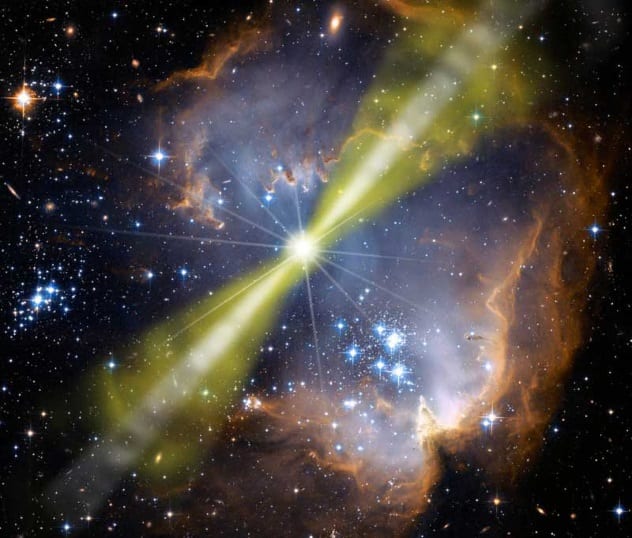
A gamma-ray burst (GRB) is an explosion of high-frequency electromagnetic radiation. A burst can give off a stream of energy greater than the Sun could produce in ten billion years, and it would happen in seconds. Scientists believe that GRBs may be caused by exploding stars or by collisions of neutron stars.
It is estimated that if the Earth were to be hit by a gamma-ray burst that occurred within the Milky Way, it would chemically damage our atmosphere, depleting the ozone layer, which protects us from ultraviolet rays, thus triggering a mass extinction. Some scientists also believe that gamma-ray bursts may give off cosmic rays, which would cause radiation sickness in anyone who managed to survive the initial impact of the GRB.
Most bursts last for less than two seconds, but a long GRB (one which lasts longer than two seconds) hitting us could cause a mass extinction on Earth. Luckily, they normally occur in far-off dwarf galaxies, but they have happened nearer to home, and scientists have speculated that gamma-ray bursts may have been responsible for past mass extinctions on Earth.[2]
So you never know.
9 Giant Solar Flare
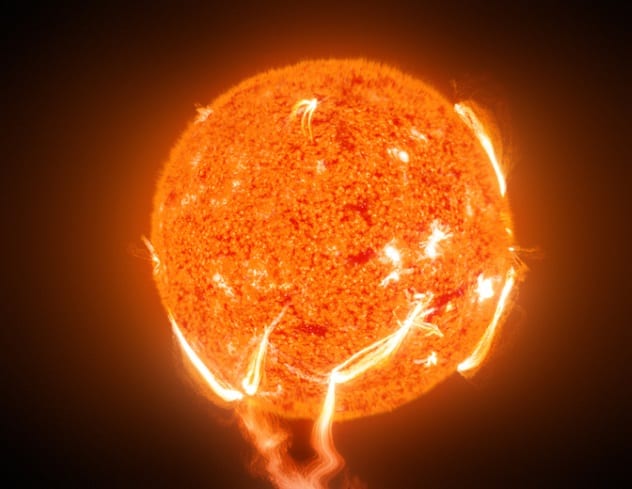
In July 2012, a solar superstorm almost ended the world as we know it. If you are wondering how you could have missed the wall-to-wall coverage of this near-miss, don’t bother. There wasn’t any.
When the giant solar flare, or coronal mass ejection, tore into the Earth’s orbit, our planet had just moved out of its path, so NASA thought it was best not to mention it. Had it hit a week earlier, it would have fried our electrical devices. The flare would have caused devastation estimated to be 20 times greater than Hurricane Katrina, and the resulting damage would have taken at least 20 years to repair.
As bad as that sounds, you may think that this does not amount to mass extinction. However, it has been theorized that an even bigger solar flare was the cause of an extinction event around 12,000 years ago, when evidence suggests that the Earth was exposed to intense UV rays for a prolonged period due to damage to the ozone layer.
A study in 2017 determined that there is a “solid chance” that a giant solar flare could hit the Earth within the next century, causing an estimated $10 trillion in damage. They found that extreme super-flares occur on the Sun once every 20 million years or so, and it seems we are due. They put the odds of an extinction event-type impact as one in 1,000, which isn’t that bad, but the odds of an impact which wipes out our electrical and technological capability are more like one in eight.[3]
So, stock up on candles.
8 Flood Basalt Events
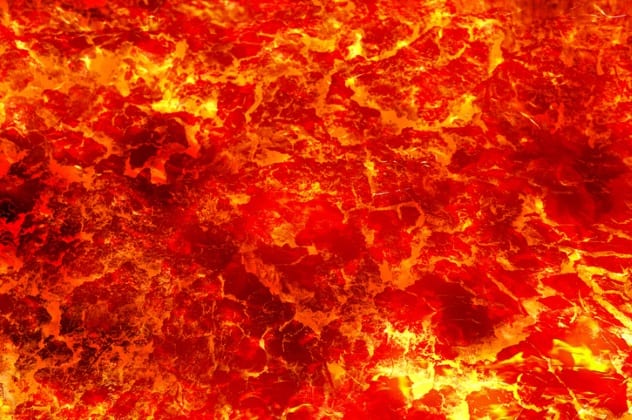
At the end of the Triassic period, half of all living species became extinct, leaving the Earth free for the dinosaurs. It was caused by a volcanic eruption so big that it could have covered the US with 91 meters (300 ft) of lava, which is pretty big.
This eruption, known as a flood basalt event, caused an increase in global temperature, a doubling of the amount of carbon dioxide in the atmosphere, and the acidification of the oceans. Some scientists believe that almost all mass extinction events in the history of the Earth have been connected to these flood basalt eruptions, rather than more popular culprits like asteroids.
The first consequence of a flood basalt event is actually cold. The fire fountains caused by the eruptions spew sulfur dioxide into the stratosphere, which reflects sunlight away from the Earth. This would be followed by acid rain and then respiratory illnesses. Livestock would die, and aircraft would be grounded. As time passes, however, the planet would actually get warmer due to all the carbon dioxide and water vapor introduced into the atmosphere by the event.[4]
Work is still ongoing to try to determine how often these flood basalt events are likely to occur and, more importantly, when the next one is due.
7 A Mishap With The Large Hadron Collider
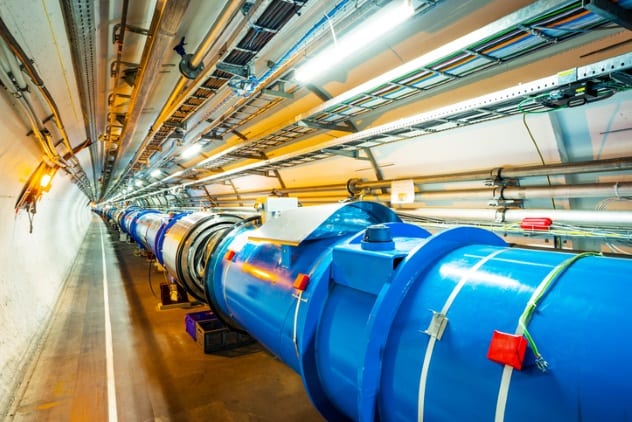
The Large Hadron Collider (LHC) is a 27-kilometer underground ring in which particles are smashed together at incredibly high speeds. Using the force of 9,300 magnets, the scientist can cause 600 million collisions per second in a kind of subatomic demolition derby.
Conditions at CERN’s main site, where the collider is kept, are strictly controlled. But accidents can happen with particle accelerators. In 1978, a Russian scientist put his head in a particle accelerator and was hit by a burst of protons traveling at nearly light speed. He was hit by 76 billion electron volts but lived to tell the tale, though doctors did not expect him to survive.
In 2009, the LHC was shut down when it began to overheat. The cause was found to be a piece of bread, dropped on a electrical substation above the collider. Most people thought that it was dropped there by a stray bird, but a pair of respected physicists, convinced that the research into the Higgs boson particle was detrimental to the fate of the universe, came up with a theory that involved a time-traveling saboteur bird sent from the future to stop the experiments.
With bread.
As bizarre as they sound, they are not alone in their concerns about the collider. Astronomer Professor Lord Martin Rees has warned that a mistake at CERN could cause a “doomsday scenario” in which the entire planet is sucked into a black hole which would compress the Earth into a hyperdense mass spanning just 100 meters (330 ft) across. And if that isn’t bad enough, there is also a theory that a mistake in the collider could cause an accident that would “engulf space itself.”[5]
6 Alien Invasion

The search for intelligent life in space has been a consuming one for many scientists and astronomers. However, not everyone thinks that looking for aliens is a good idea. Professor Stephen Hawking believed that instead of trying to make contact with alien life-forms, we would be better served by trying to hide from them.
He postulated that, given the number of planets we know exist, there must be other life-forms in the universe, least some of which will be of superior intelligence, with greater technological and military capability. And, Hawking suggested, if they did come, it would be more in the manner of a conqueror than an ambassador.
If aliens do make contact with Earth, it’s possible that the Chinese will be the first to hear them, since they have invested heavily in alien contact technology, building the world’s largest radio dish for this purpose. But if aliens do make contact, there is no single protocol for how Earth will collectively respond, nor is there anything to stop enthusiastic amateurs from projecting any message they like to listening aliens.
And what if they don’t call first but just show up? Given the amount of resources required and the length of time it would take, it is unlikely that it would be for a casual visit. As Stephen Hawking said, “If aliens visit us, the outcome would be much as when Columbus landed in America, which didn’t turn out well for the Native Americans.”[6]
5 Swallowed By A Black Hole
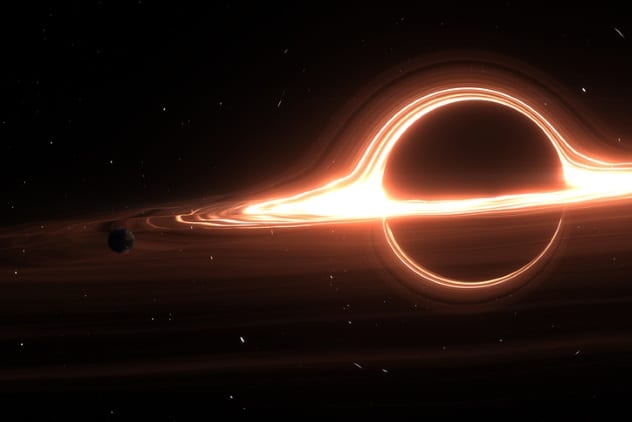
Even without the help of CERN, there is a possibility that Earth could be swallowed by a black hole. A black hole is defined as a concentration of mass great enough that the force of gravity prevents anything from escaping it, even light.
There are many things that can cause a black hole. One of the stars of the Eta Carinae stellar system, for example, is close to going supernova. It is even possible that it has already exploded, but the image of the event still light-years away.
When the star does go, its core could collapse in on itself, forming a neutron star or a black hole. Some have claimed that if a black hole does form, it will swallow the remains of Eta Carinae and could take the Earth with it. Scientists have said that this is extremely unlikely, however.
All the same, it is possible, albeit with long odds, that a rogue black hole could happen upon our solar system. If that were to happen, the Sun and all the planets would likely be ripped apart.[7]
Well, that’s comforting.
4 Nuclear War
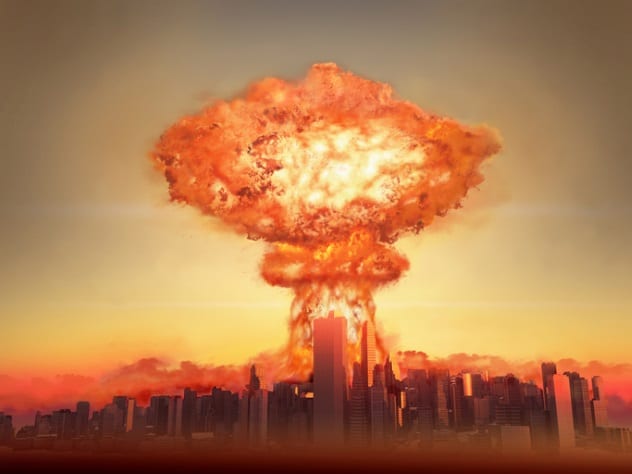
The threat of nuclear war has hung over the Earth since the mid-20th century. Though the threat has waxed and waned over the decades, the potential for nuclear war appears to have become more prominent in the last few years.
Should a nuclear war break out today, it has been predicted that the fallout would be “similar to the extinction of the dinosaurs.” Soot created from the destruction would alter the climate, cooling the Earth’s surface and heating the upper atmosphere, with “potentially devastating effects.”
Nuclear war was narrowly averted during the Cuban Missile Crisis by a combination of public tough talking and private diplomacy on both sides. Khrushchev wrote to Kennedy, “If there is no intention to tighten that knot and thereby to doom the world to the catastrophe of thermonuclear war, then let us not only relax the forces pulling on the ends of the rope, let us take measures to untie that knot.”
Today, the threat of nuclear war is again said to be “dangerously close,” and the fate of the world may lie in the diplomatic skills of various nations and their leaders.[8]
3 Supervolcano Eruption
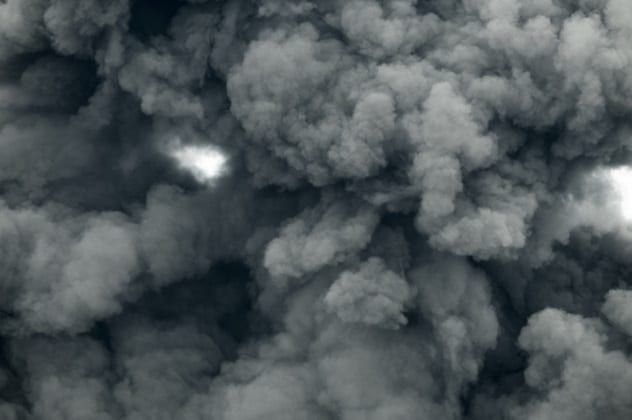
Campi Flegrei is a supervolcano nestled in the Bay of Naples. The volcano, whose name means “burning fields,” consists of a vast network of underground chambers, filled with magma, largely under the sea. Campi Flegrei has not erupted for over 500 years (and that was a tiny one), but it seems that this may soon change. In December 2016, volcanologists warned that the volcano could be reaching “critical degassing pressure,” which could lead to an eruption.
That would be bad. Around 39,000 years ago, the volcano once “punched” 300 cubic kilometers (72 mi) of molten rock 70 kilometers (43 mi) up into the air and emitted 450,000 tons of sulfur dioxide. The ash landed as far as 2,000 kilometers (1,200 mi) away. The eruption had devastating, centuries-long consequences for Europe. The sulfur dioxide released by the eruption precipitated a volcanic winter, covering the land in ash 20 centimeters (8 in) deep and blocking heat from the Sun.[9]
Nor is Campi Flegrei the only supervolcano in existence. Lake Toba in Indonesia, Yellowstone Park in the US, and the Taupo caldera in New Zealand are all the sites of supervolcanoes which have the potential to wipe out large swathes of the population and turn the land into desert, should any of them erupt. Experts are working to be able to predict when the eruptions are likely to occur. Geologists studying the Yellowstone supervolcano believe that there is an average gap of 740,000 years between eruptions, which would mean that Old Faithful should be safe for at least another 100,000 years.
Lets hope all supervolcanoes are just as reliable.
2 Methane Burst

Most apocalyptic scenarios involve drama, danger, and a high degree of explosions. But how about a microbe that spews methane?
It has been theorized that just such a catastrophe occurred 252 million years ago, killing 90 percent of marine creatures and 70 percent of those on land in one of the five major mass extinctions in the history of the Earth. They believe that Methanosarcina, a microbe that produces methane, grew unchecked in the oceans, causing the climate to heat up, resulting in the acidification of the seas and the extinction of life. The microbe flourished on the minerals produced by large-scale volcanic eruptions in Siberia, which increased the concentrations of nickel required for its growth.
So, how likely is it that another methane burst will wipe out life on Earth? Well, quite likely, it seems. It is believed that the Arctic is a “ticking time bomb” of methane. Methane is said to be trapped in the permafrost in the form of methane hydrate and methane clathrate. Should too much ice melt, a world-ending mass extinction event could be triggered.[10]
1 Vacuum Decay
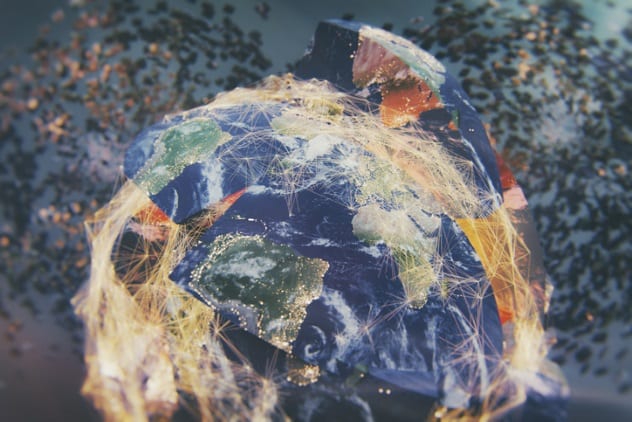
The universe is held in a vacuum. And our vacuum is jostled up against the vacuums of other universes. However, some of these vacuums are not true vacuums. And if the vacuum of a universe is a false vacuum, it is potentially unstable, or “metastable.”
If our universe is held in a false vacuum, then any high-energy event, such as an exploding star, might cause part of our universe to knock against the true vacuum of an adjoining universe, which would create a bubble that would expand at the speed of light and suck the entire universe in.
Not only that, but a universe that was sitting, minding its own business, in a false vacuum, can be “tunneled into” by a tiny particle that broke through the barrier separating one vacuum from another, which would also result in the false-vacuumed universe being sucked into the other.
So, do we live in a vacuum or a false vacuum? It is not certain. However, work on the measurements of the Higgs boson seem to indicate that our vacuum may be metastable.[11] It is predicted that if we were to be sucked into a true vacuum, we would all be annihilated instantly as the bubble wall moves through our galaxy at the speed of light. There would be no survivors.
It’s not all bad news, though. The lifetime of a metastable universe is thought to be especially long, so we will probably be okay for a while. And if we are all sucked into a vacuum, it would happen so fast that we wouldn’t know about it.
So, nothing to worry about.
Read about more ways our world could end on 10 Science Fiction Doomsdays That Could Theoretically Happen and 10 Violent Events That Will Hit Our Solar System.








